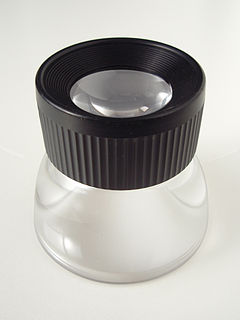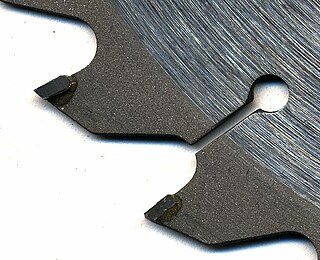
A machinist is a person who machines using hand tools and machine tools to create or modify a part that is made of metal, plastics, or wood.

Drill bits are cutting tools used to remove material to create holes, almost always of circular cross-section. Drill bits come in many sizes and shapes and can create different kinds of holes in many different materials. In order to create holes drill bits are usually attached to a drill, which powers them to cut through the workpiece, typically by rotation. The drill will grasp the upper end of a bit called the shank in the chuck.

A surface plate is a solid, flat plate used as the main horizontal reference plane for precision inspection, marking out (layout), and tooling setup. The surface plate is often used as the baseline for all measurements to a workpiece, therefore one primary surface is finished extremely flat with tolerances below 11.5 μm or 0.0115 mm per 2960 mm for a grade 0 plate. Surface plates are a very common tool in the manufacturing industry and are often permanently attached to robotic-type inspection devices such as a coordinate-measuring machine. Plates are typically square or rectangular.

A grinding wheel is a wheel composed of an abrasive compound and used for various grinding and abrasive machining operations. Such wheels are used in grinding machines.
A grinding dresser or wheel dresser is a tool to dress the surface of a grinding wheel. Grinding dressers are used to return a wheel to its original round shape, to expose fresh grains for renewed cutting action, or to make a different profile on the wheel's edge.

In sewing and fashion design, a pattern is the template from which the parts of a garment are traced onto fabric before being cut out and assembled. Patterns are usually made of paper, and are sometimes made of sturdier materials like paperboard or cardboard if they need to be more robust to withstand repeated use. The process of making or cutting patterns is sometimes condensed to the one-word Patternmaking, but it can also be written pattern(-)making or pattern cutting.

State Trunk Highway 29 is a state highway running east–west across central Wisconsin. It is a major east–west corridor connecting the Twin Cities and the Chippewa Valley with Wausau and Green Bay. A multi-year project to upgrade the corridor to a four-lane freeway or expressway from Elk Mound to Green Bay was completed in 2005. The expansion served to improve safety on the route, which was over capacity as a two-lane road. The remainder of WIS 29 is two-lane surface road or urban multi-lane road.

An end mill is a type of milling cutter, a cutting tool used in industrial milling applications. It is distinguished from the drill bit in its application, geometry, and manufacture. While a drill bit can only cut in the axial direction, a milling bit can generally cut in all directions, though some cannot cut axially.

Sharpening stones, water stones or whetstones are used to sharpen the edges of steel tools and implements through grinding and honing.

Replacement arthroplasty, or joint replacement surgery, is a procedure of orthopedic surgery in which an arthritic or dysfunctional joint surface is replaced with an orthopedic prosthesis. Joint replacement is considered as a treatment when severe joint pain or dysfunction is not alleviated by less-invasive therapies. It is a form of arthroplasty, and is often indicated from various joint diseases, including osteoarthritis and rheumatoid arthritis.

In machining, boring is the process of enlarging a hole that has already been drilled by means of a single-point cutting tool, such as in boring a gun barrel or an engine cylinder. Boring is used to achieve greater accuracy of the diameter of a hole, and can be used to cut a tapered hole. Boring can be viewed as the internal-diameter counterpart to turning, which cuts external diameters.

A diamond tool is a cutting tool with diamond grains fixed on the functional parts of the tool via a bonding material or another method. As diamond is a superhard material, diamond tools have many advantages as compared with tools made with common abrasives such as corundum and silicon carbide.
TerraNova is a series of standardized achievement tests used in the United States designed to assess K-12 student achievement in reading, language arts, mathematics, science, social studies, vocabulary, spelling, and other areas.

A loupe is a simple, small magnification device used to see small details more closely. Unlike a magnifying glass, a loupe does not have an attached handle, and its focusing lens(es) are contained in an opaque cylinder or cone or fold into an enclosing housing that protects the lenses when not in use. Loupes are also called hand lenses.

Cemented carbide is a hard material used extensively as cutting tool material, as well as other industrial applications. It consists of fine particles of carbide cemented into a composite by a binder metal. Cemented carbides commonly use tungsten carbide (WC), titanium carbide (TiC), or tantalum carbide (TaC) as the aggregate. Mentions of "carbide" or "tungsten carbide" in industrial contexts usually refer to these cemented composites.
DIN 1.2344 tool steel is a tool steel grade standardised for hot working. The main feature of this grade is the combination of alloyed elements of chromium, molybdenum and vanadium, Cr-Mo-V, which provides a high wear resistance to thermal shock. It is well known as for its great strength, and heat resistance. It is heavily used for die casting in the cold heading field.
The presence of high vanadium in DIN 1.2344 can handle the abrasion at both low and high temperatures. It always provides a uniform and high level of machinability. This tool steel is mostly used for aluminum, magnesium and zinc die casting.
Code page 1104, also known as CP1104, F7DEC, ISO-IR-025 or NF Z 62-010 (1973) is an IBM code page number assigned to the French variant of DEC's National Replacement Character Set (NRCS). The 7-bit character set was introduced for DEC's computer terminal systems, starting with the VT200 series in 1983, but it is also used by IBM for their DEC emulation.
ISO 7010 is an International Organization for Standardization technical standard for graphical symbols on hazard and warning signs, including those indicating emergency exits and safety signs. It uses colours and principles set out in ISO 3864 for these symbols, and is intended to provide "safety information that relies as little as possible on the use of words to achieve understanding." It is distinct from the Globally Harmonized System of Classification and Labelling of Chemicals specified by the United Nations to standardise hazardous material classification and labelling.















